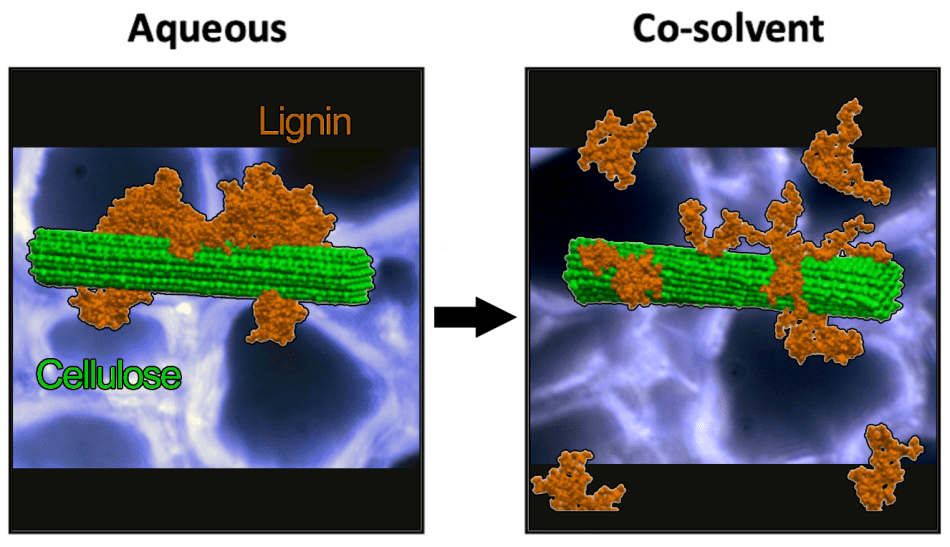Aug 5 2019
Fuels developed from forestry or agricultural wastes are called lignocellulosic biomass. Such fuels have traditionally been a champion in the search for reducing the use of fossil fuels.
 Co-solvents THF and water cause lignin to dissociate from itself and cellulose, expanding into a random coil. (Image credit: Charles Cai/UCR)
Co-solvents THF and water cause lignin to dissociate from itself and cellulose, expanding into a random coil. (Image credit: Charles Cai/UCR)
However, innate defenses in plant cell walls make it more difficult and expensive to break down this process.
Now, a team of scientists at the University of California, Riverside has collaborated with research teams at the University of Central Florida and Oak Ridge National Laboratory to produce a chemical roadmap to overcome these defenses. This breakthrough development could redefine one’s understanding of how plant biomass can be broken down more efficiently.
Plant cell walls contain an abundant amount of energy-rich sugars. In order to access these sugars, scientists have renewed their focus on solvating lignin—a complex polymer that is also present in plant cell walls and serves as a natural shield, inhibiting both biological and chemical attack.
More specifically, lignin is effective in inhibiting commercially available enzymes from digesting cellulose, which constitutes the bulk of sugars present in biomass.
Earlier, various pretreatment techniques and specialized chemicals have been used to enhance enzyme access to cellulose, but these were not effective at eliminating lignin. While the use of sulfite, ionic liquid, strong acids, and ammonia treatments has slightly enhanced the digestibility of cellulose, these techniques cannot fully remove this polymer, making it costly to recover cellulose.
Other techniques have used co-solvents such as acetone and ethanol solvate to eliminate lignin, but these methods demand extremely high-reaction temperatures that also break down the remaining sugars.
Therefore, economically feasible techniques of converting biomass into biofuels have not been achieved yet.
Abhishek S. Patri, a doctoral student in chemical and environmental engineering, and Charles Cai, an assistant research engineer at the Center for Environmental Research and Technology in the Marlan and Rosemary Bourns College of Engineering at UC Riverside, headed a research team, taking a whole new direction in this field.
The team focused on detecting highly unique co-solvents—substances that are added to a main solvent to render it more effective. These specialized co-solvents can enable milder temperature solvation and eventually allow the release of lignin from the cell walls of the plant. This is called a “lignin-first” method developed to degrade biomass.
The scientists at UC Riverside enlisted the research team at Oak Ridge National Laboratory’s Center of Molecular Biophysics, headed by Jeremy Smith, to help build a 1.5 million atom molecular simulation to demonstrate how the co-solvent pair containing water and tetrahydrofuran (THF) is especially effective at modifying the interactions between cellulose and lignin.
Such an approach would help drive numerous key mechanisms that are responsible for degrading the biomass.
The scientists observed that when the plant biomass is pretreated with THF-water, the lignin globules present on the surface of the cellulose expands and breaks away from each other and away from the cellulose fibers. Also, this expanded lignin was further exposed to catalytic fragmentation through dilute acid. Consequently, the expanded lignin can be more efficiently depolymerized, solubilized, and ultimately transported from the plant cell wall at milder treatment conditions.
In addition, the nearly complete elimination of lignin made the residual cellulose fibers more sensitive to enzyme attack. As a matter of fact, following the mild THF co-solvent treatment, the enzymes introduced into the residual cellulose-rich solids attained complete hydrolysis to glucose sugars.
At the University of Central Florida, collaborating scientists, headed by Laurene Tetard, helped in validating the findings made from the enzymatic studies and molecular simulations. This was achieved by using nano-infrared imaging and robust lasers to optically track the rearrangement and removal of lignin rom the cell wall of extremely thick pieces of hardwood.
Scientists Arthur Ragauskas and Yunqiao Pu from Oak Ridge National Laboratory demonstrated that lignin—obtained from hardwood pretreated with THF co-solvent—was considerably depolymerized and included fewer undesired reactions when compared to lignin obtained from other acidic pretreatment techniques.
By placing lignin first, highly functional co-solvents can help in incorporating numerous processing steps. They would also make it easy to recover sugars and lignin, which can serve as useful chemical building blocks and make renewable fuel production not only easier but also more cost-effective.
According to the researchers, exposing the synergistic mechanisms of biomass breakdown by THF and water co-solvents can also motivate others to detect more multifunctional co-solvent pairs.
The paper, titled “A multifunctional co-solvent pair reveals molecular principles of biomass deconstruction,” has been reported in the Journal of the American Chemical Society.
Apart from Cai and Patri, other authors include Barmak Mostofian; Yunqiao Pu; Nicholas Ciaffone; Mikhael Soliman; Micholas Dean Smith; Rajeev Kumar; Xiaolin Cheng; Charles E. Wyman; Laurene Tetard; Arthur J. Ragauskas; Jeremy C. Smith; and Loukas Petridis.